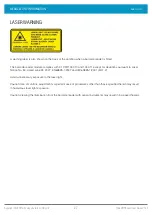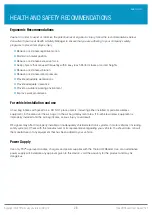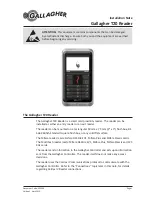
1166 UHF Reader User Guide V1.07
Copyright © 2019 Technology Solutions (UK) Ltd
13
CONNECTIONS
COMPARISON OF
BLUETOOTH
®
OPERATING MODES
Our UHF RFID
Bluetooth
®
readers support two modes of operation over
Bluetooth
®
. When connected via USB the
reader always supports the TSL ASCII 2 protocol, but when connected over
Bluetooth
®
the reader can either be set
to use the TSL ASCII 2 protocol (
Bluetooth
®
SPP Mode) or it can appear as a
Bluetooth
®
keyboard (
Bluetooth
®
HID
Mode).
The comparison chart below is designed to help you understand the differences between the two operating modes:
Bluetooth
®
SPP Mode
Bluetooth
®
HID Mode
Apps need to be written with specific support for the
Reader
Apps can use the Reader without modification
The Reader can be discovered and paired in the
Bluetooth Settings or from within the App but the App
controls the connection
●
Connects when instructed by the App
●
Disconnects when instructed by the App
●
The reader powers off when no longer connected and
idle
●
The App needs to connect to restore
Reader is discovered and paired in the Host Bluetooth
Settings (often appears as a Keyboard)
●
After pairing the reader connects automatically
●
If idle the reader sleeps and the connection is
dropped
●
The reader, when woken, automatically reconnects to
the host device
Apps receive and interpret TSL ASCII 2 Protocol
responses when the user triggers a UHF or barcode scan
Apps receive input as Key strokes from the reader
including Tab and Return/Enter keys
The App can respond and react intelligently to responses
e.g.
●
duplicate responses can be ignored or counted
●
incoming tag data can be truncated, stripped or
transformed into alternative representations: Hex,
ASCII, GS1 EPC URI, etc…
The reader types text for each barcode/UHF scan
received
●
The tag values can be returned in Hex or ASCII
representations
●
Up to 2 Additional characters can be inserted before
and after the text sent
●
The reader cannot truncate or strip values from tag
data
The App can change the Reader’s behaviour
The Reader can only send scanned data to the host, the
host cannot change the reader’s behaviour
The Reader’s behaviour and command parameters are
controlled in real time by the App e.g. the trigger action
can change to suit the task that the User is performing;
the App can allow the User to specify Inventory output
power
The Reader’s behaviour, such as the action of the reader’s
trigger switch, the inventory output power, the idle
sleep timeout and other command parameters can be
configured only once at start-up.
Configuration is held within the App (any configuration
in the AUTO.TXT is likely to be overridden by the App
settings)
All configuration is held in an AUTO.TXT file stored on an
SD-Card. Removing the SD-card or deleting the AUTO.
TXT and power-cycling the unit restores default settings.
All reader activity, by default, is saved to a log file if an
SD-Card is fitted.
All reader activity, by default, is saved to a log file if an
SD-card is fitted.
www.tsl.com














































